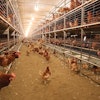
The Brazilian poultry industry may have seen production rise last year and broken yet more records, but 2022 was not without its problems for the world’s second largest poultry producer.
The volume of chicken meat produced in the country rose by 1.37%, but per capita chicken consumption declined slightly. The value of exports rose by over a quarter, but production costs were at an all-time high.
In the forward to the Brazilian Association of Animal Protein (ABPA)’s 2023 annual report, Riccardo Santin, the association’s president, notes that, in 2022, the costs of corn, soya, packaging materials, electricity and biodiesel all reached record highs.
Alongside these difficulties for producers, the impact of the pandemic continued to affect consumer consumption throughout the year. It was in the country’s 145 export markets where demand for Brazilian chicken and other poultry meats really flew.
Chicken production
Chicken production in Brazil stood at 14.52 million metric tons (MT) in 2022, an increase of almost 1.37% on 2021’s figure of 14.32 million MT. Total chicken meat output was worth R$112.1 billion (US$22.54), up from 2021’s R$108.9 billion – a 2.9% increase.
The home market absorbs 66.8% of the country’s chicken meat production. Consumption has been relatively stable over the last decade, reaching a low of 41.1 kg per capita in 2016. 2021 marked a high point, with per capita consumption reaching 45.6 kg. In 2022, it declined slightly to 45.2 kg.
Chicken exports
While per capita consumption in its home market may have disappointed somewhat last year, the same cannot be said for exports. With disruption to international markets resulting from avian influenza and the war in Ukraine, demand in exports was high, and, by value, Brazil’s chicken meat exports reached US$9.7 billion, an increase of 26.56%.
A little over a third of the country’s chicken production is sold into international markets. Brazil, the biggest chicken meat exporter in the world, by volume saw its exports grow by 4.36% to stand at 4.811 million MT.
Asia took 36.25% of the country’s chicken meat exports last year by volume, followed by the Middle East, which took 29.48%. Africa, the third most important export destination, absorbed 15.49%.
Brazil now sells its chicken meat into 145 countries, with China and the United Arab Emirates being the two most important export destinations.
Cuts accounted for 72% of exports, with 48% of cuts going to Asia. Whole birds accounted for 21.9%, with 76% going to the Middle East.
Turkey and duck production
2022 saw growth in the far smaller turkey sector outstrip that recorded by the chicken industry, with output rising by 3.27% to stand at 162,200 MT. This expansion is the first recorded by the industry since 2018’s significant contraction, and output still remains at less than half of that produced in 2017.
Alongside this turnaround in production fortunes, the value of turkey meat exports rose significantly. Brazil now exports turkey meat to 69 countries and in 2022, foreign demand was worth US$189 million – an increase of 71.04% in comparison with the year before. Volumes rose by 24.53% to stand at 59,000 MT.
Despite this success in overseas markets, per capita turkey meat consumption on the home market fell slightly to 0.4 kg, continuing the declines seen over the two previous years.
For Brazil’s duck and minor species poultry producers, 2022 was not quite so positive. At 4,800 MT, output was 5.56% lower. By volume, exports contracted by 16.57% to 2,900, but by value they were 2.09% higher with a value of US$11 million.
Almost 61% of Brazilian duck and minor species meat is exported, with almost three quarters going to the Middle East.
On the home market, consumption per head was the same as last year, at 0.008 kg.

While per capita consumption across species may have declined in Brazil last year, it was in overseas markets where demand for chicken, turkey and duck meat generated significantly higher incomes. GlobalP | iStock.com
Egg production
Brazil recorded egg production of 52 billion units in 2022, a contraction of 5.28%. Despite this, the sector achieved sales of R$20.2 billion – a 13.9% increase.
Per capita egg consumption in the country has been growing over the last decade. In 2020, it stood at 148 and, last year, at 241. However, as for chicken meat, per capita egg consumption contracted slightly in comparison with 2021’s record high of 257.
Where exports are concerned, the world’s fifth-largest egg producer and primary export region is the Middle East, which absorbs 64.41% of its overseas egg sales. Total egg exports last year increased by 24.2% in value, but by volume they contracted by 16.5% to stand at 9,400 MT.
Brazil looking forward to another record year

















